Gemsteed (jEHm-stEEd)
"That has to be the strangest creature I have ever seen."
Gemsteeds are large four-legged insectivores endemic to the upper grasslands of Sanoris. During the Dusk year they are covered in thick white fur. When the Dawn year comes around, they shed the white to reveal a beautiful metallic undercoat. They can be tamed, and are useful as beasts of burden and mounts--particularly during Nystylvrn season.
Basic Information
Anatomy
Gemsteeds have a body shape similar to that of a deer, with a long neck, narrow face, stocky body, and four long legs. Their face tapers to a very thin trunk with their mouth at the end of it. Their nostrils sit further up their face, closer to their eyes. Their eyes are on the sides of their head, granting them near 360-degree vision. They have fox-like ears that can rotate in many directions.
They have three digits on the end of each foot. Their front legs have two toes and a clawed thumb. Their hind legs have three large toes. Each of their toes end in a tough hoof. Their legs are proportionally very long compared to their body, an adaptation that allows them to walk through thick snow and tall grass with little issue.
Winter and Summer Variation
Gemsteeds look very different in the Dusk year than they do in the Dawn year. During Dusk, they are covered in thick, fluffy white fur. Their fur is so well insulated that it gives off very little infrared radiation. Combined with the white color, their winter coat makes them much trickier for hungry Nystylvrn to spot.
During the summer, they shed their winter coat when the weather warms and the threat of being devoured has passed. Underneath the thick layer of white is what gives the gemsteed its name: beautiful metallic fur, shiny enough to see a warped reflection. They come in any color of the rainbow except for yellow. Nobodys knows why there are no yellow gemsteeds; perhaps other gemsteeds find it unattractive.
The color of a gemsteed's tongue is always a similar color to its undercoat. Winter gemsteeds can be identified by the colors of their tongues. Small bits of colored fur are also visible inside the ears.
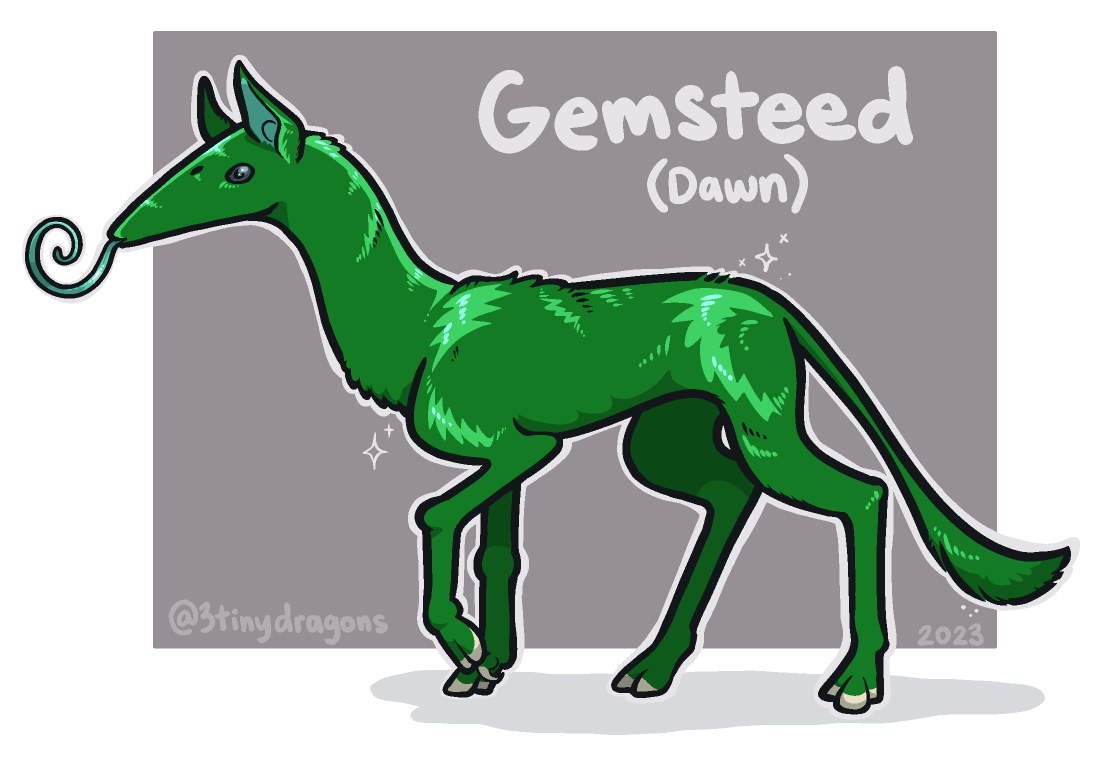
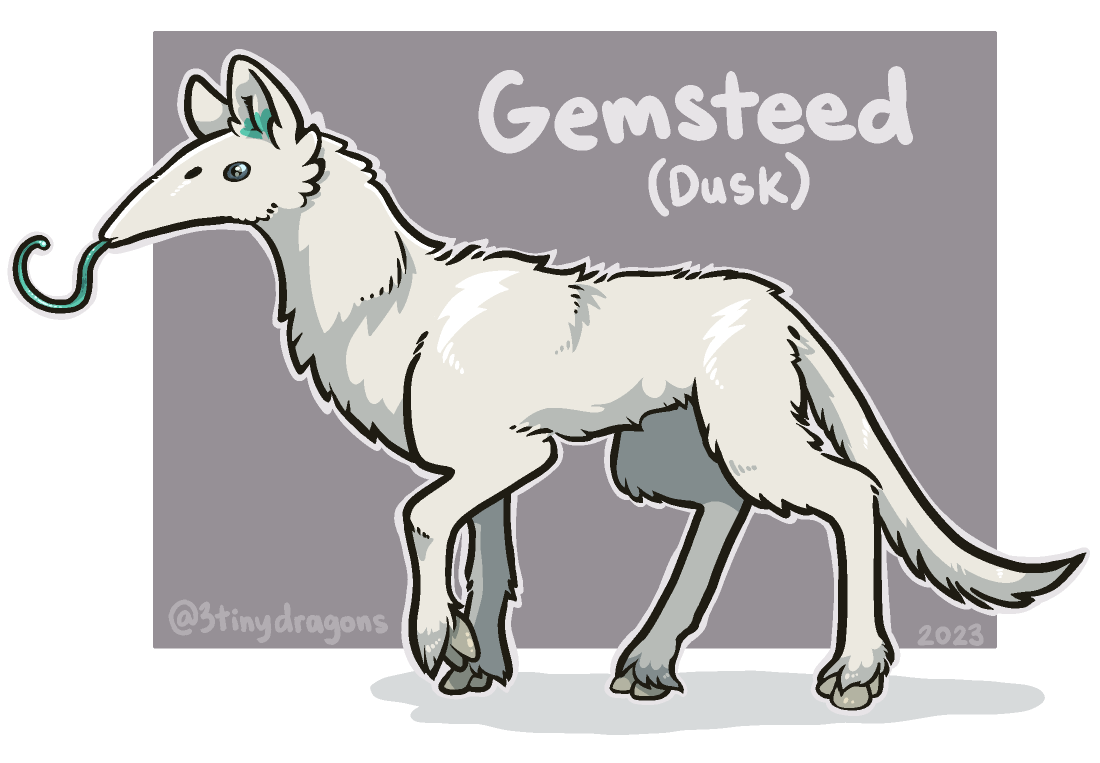
Perception & Sensory Capabilities
Gemsteeds have superior senses that help them avoid danger and seek out their favorite food: bugs. Their ears are large and rounded, which allows them to pick up the slightest skittering sounds. When they find a snack, they burrow their long snouts into the snow or soil and use their 14-inch long tongues to lick up their prey.
Their tongues can do more than just taste. They are equipped with electroreceptors that allow them to sense nearby insects in the ground, even when the gemsteed can't see them. This special ability allows the gemsteed to find their target quickly, so their vulnerable tongues aren't exposed to the cold for too long.
Genetics and Reproduction
Gemsteeds reproduce sexually in the second quarter of Dawn years. They prefer other gemsteeds with shinier, brighter colored coats. Male gemsteeds will take possession of a small group of females. During mating season, they often battle each other with their hooves and sharp dewclaws over the right to breed.
Gestation lasts 7 to 8 months and ends with the birth of a single calf. Twins are rare but not impossible. Gemsteed calves can stand up and walk as soon as they are born. They learn how to forage for insects after a month, but continue to nurse from their mothers until the Dusk returns.
Gemsteed calves are born gray, brown, or black to help them stand out less to predators. After their first Dusk year, they will shed their coats to reveal a brand new sparkly undercoat. The color of a gemsteed is genetically determined by the colors of its parents.
Ecology and Habitats
Gemsteeds rotate between the plains and the forest depending on the time of day and the type of year. During Dawn years, they spend the majority of their time on the plains foraging for food and searching for mates. With no threat of Nystylvrn, gemsteeds are comfortable remaining in the open during the night.
When the Nystylvrn hatch at the beginning of a new Dusk year, gemsteeds adjust their habits. They spend the first half of the evening searching for hotworms, which are most active after sunset. Once they have eaten their fill, they retreat into the forest to bed down where the Nystylvrn can't find them.
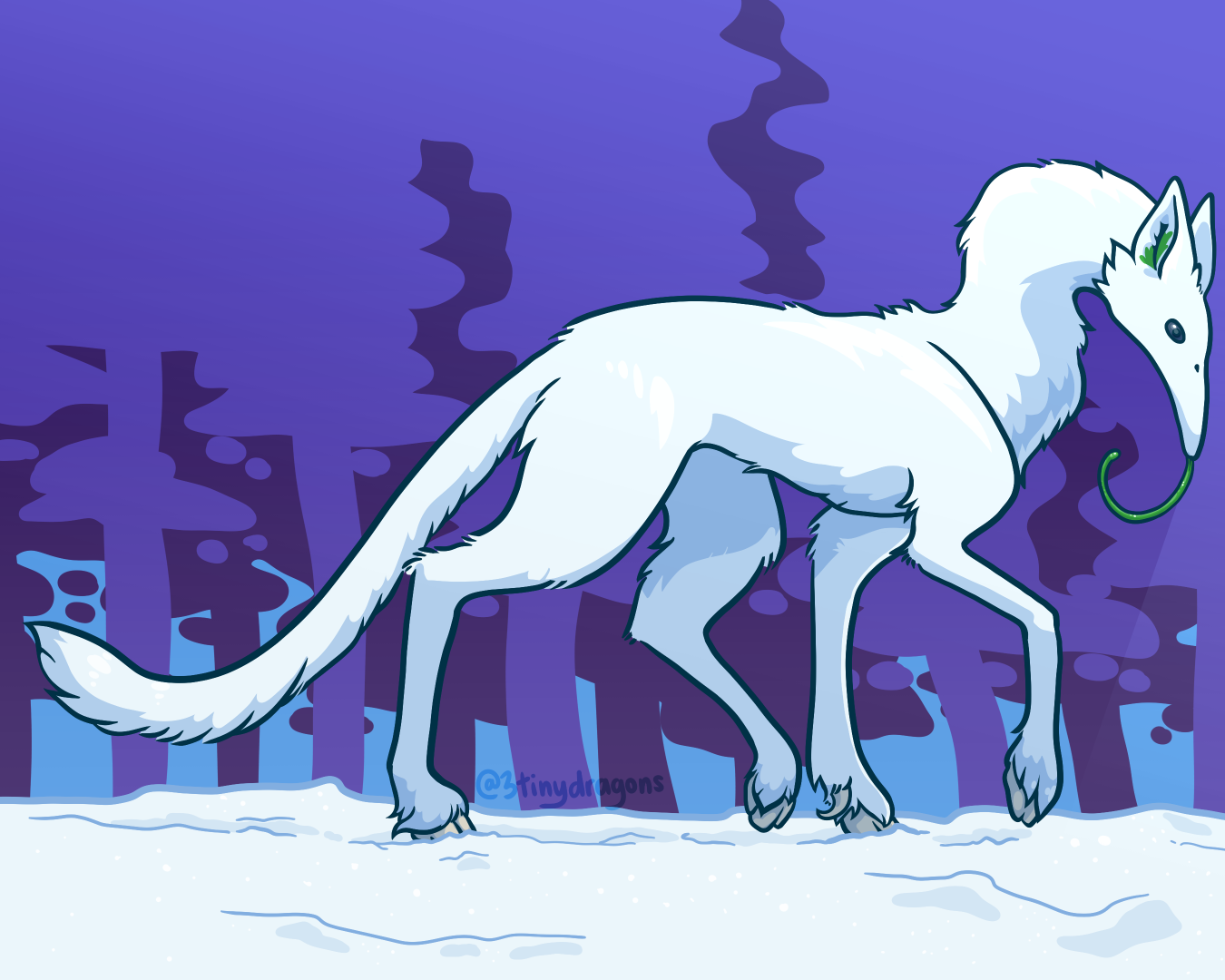
Dietary Needs and Habits
Gemsteeds are omnivores that mostly eat insects. During the Dusk year they eat almost exclusively hotworms, a species of Glowbug that uses hot Glow to burrow through the snow. The edylium that gemsteeds consume from hotworms is likely what gives their undercoat such a beautiful sheen.
During the Dawn year, food is much more abundant. Gemsteeds gorge themselves on a wide variety of insects and arachnids, including worms, centipedes, spiders, ants, and beetles. They also enjoy nibbling on the leaves of low-growing shrubs. They use their long tongues to strip the leaves from the branches.
"Are you sure it won't bite!?"
"Relax, it couldn't bite you if it wanted. The worst it'll do is get its tongue caught in your hair."
"Its what!?"
Gemsteeds have only four pairs of small molars in the back of their mouth that they use to crush the shells of insects and grind up plant matter. They physically cannot open their mouths wide enough to bite anything, and must exclusively use their tongues to eat.
This makes it difficult to diagnose the dental health of domestic gemsteeds. It has to be inferred from their behavior and the health of their tongue.
Additional Information
Social Structure
Herds of gemsteeds typically have six to ten individuals. During Dusk years, the herds are made up of females, their calves, and the reigning male from the last Dawn year. When Dawn year arrives, any male calves leave their herds in search of their own females, and the reigning male is challenged by newcomers from other herds. If he loses, he is forced to find a new herd. If he doesn't find one by the end of Dawn, he doesn't get to mate, and he must spend the Dusk year alone.
While the reigning male gets breeding rights over the herd, he is not the leader. The senior matriarch has the last say. She decides where the herd goes to forage and rest. She can also decide to kick out the reigning male if he doesn't respect her.
Domestication
Gemsteeds are docile but wary. They can be tamed with enough patience and effort. The trust of a whole herd can be gained if the confidence of the senior matriarch is earned. This is easiest to do in all-female herds with no reigning male. Male gemsteeds are more difficult to tame than females because of their impatient and fiery attitudes.
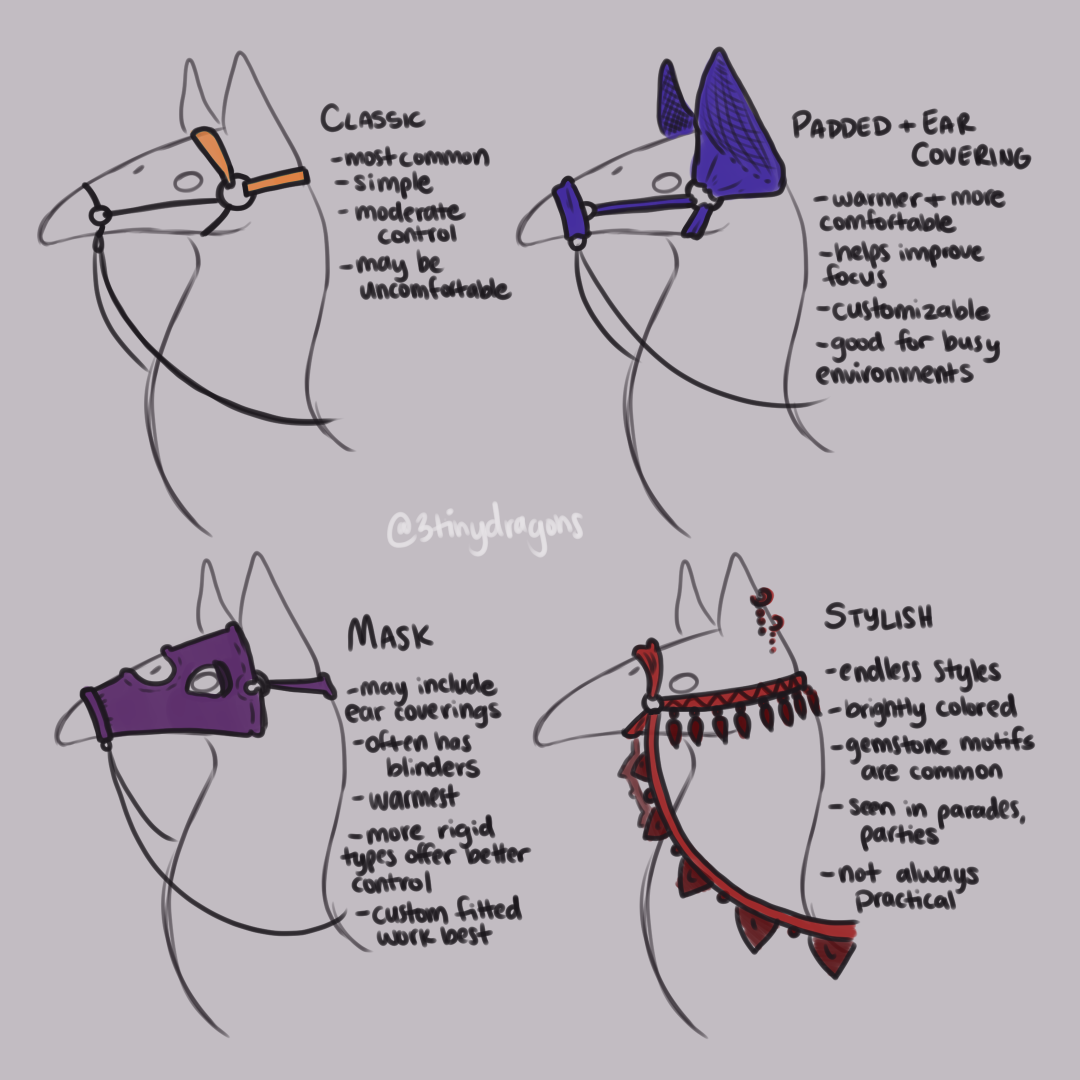
It can take time to get a gemsteed used to bearing burdens, but after they are trained, they are excellent steeds and loyal companions. It is not uncommon for a gemsteed and its owner to develop a deep emotional bond. Many people find their strange long faces quite endearing.
Domesticated gemsteeds enjoy meals of crushed bugs, sometimes mixed with sugar. They have a strong sweet tooth, and their affections are easily bought with a tasty bowl of glazed hotworms. Domesticated gemsteeds can easily live to be twenty years old with someone to care for them.
Gemsteeds are most useful as mounts during Nystylvrn season, as they are far less likely to be detected than other options. They are not invisible, though, and their rider must also take precautions by wearing white, well-insulated clothing and refraining from carrying any light source--especially ones that emit heat. The bond of trust between a gemsteed and its rider must be strong before the gemsteed allows themselves to be led into Nystylvrn territory after dark.
Uses, Products & Exploitation
Gemsteed winter fur is very valuable for its insulation properties. The fur is cleaned, carded, and spun into yarn, which is then used to make gloves, socks, cloaks, hats, scarves, and even warm underwear. Many articles of clothing can be made from the coat of a single gemsteed. Its natural whiteness also makes it easy to dye in many colors. Dyed gemsteed fur is beautiful and vibrant. However, if the clothes are to be worn where the Nystylvrn hunt, it is best to keep them white.
Each Dawn year, new clothes can be made from the shed coats. Owners of gemsteeds sell the fur to clothiers. Others will scavenge the plains for clumps of fur left behind by wild herds. Clothing made from gemsteed yarn is in high demand, and the race to get it before it's gone can be quite intense.
Significantly less valuable is the meat of a gemsteed. It is chewy and has a strong flavor that few enjoy. It is only edible when boiled for a long time to soften it, which often turns it into a gelatinous mess. Gemsteed jerky is slightly more tolerable, but still only eaten as a last resort.
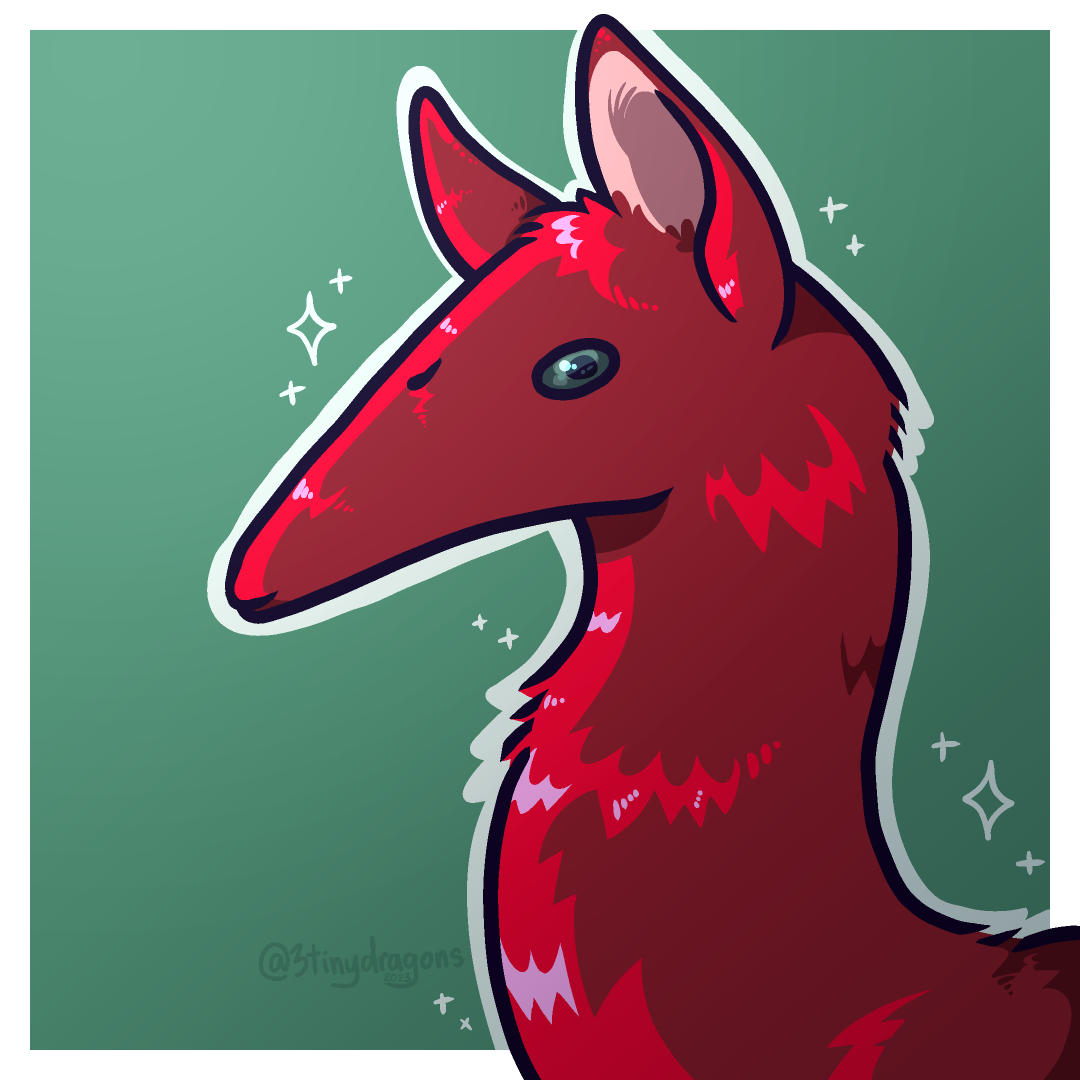
Use in Heraldry
The image of a gemsteed is easily recognizable and used frequently in the flags and crests of countries they are native to. They have a mystical reputation to foreigners because of their odd appearance, so they sometimes appear in iconography outside of their homeland. Summer gemsteeds can represent opulence, prosperity, or fertility. Winter gemsteeds may represent endurance, resilience, and fortitude.
They are not agile or brave enough to be used as war mounts, but they often appear on banners to represent the determination of the wielding army. They are often ridden during military parades, especially during the summer. When it is not summer, their white coats are adorned with jewels and other brightly colored items.
Appearance in Mythos
In folk tales, the gemsteed often has a level-headed, cautious personality. They are often the protagonists of their stories. Sometimes they are guardians or sources of wisdom for the protagonist. The "wise gemsteed" archetype is almost always female. Male gemsteeds are depicted as brash and impulsive in folklore.
Outside of where they are native, gemsteeds have a much more mystical reputation. Foreigners misunderstand their sparkling coats as a signifier that they are Glowfauna. They are rumored to have a wild assortment of powers such as glowblasting swarms of Nystylvrn from the air, inflicting frost burn on enemies with their tongues, and sometimes even summoning dragon wings! None of these rumors are true. Despite all of the edylium that they consume, gemsteeds have no Glow abilities.
Public Perception
Those familiar with gemsteeds tend to have a positive opinion of them and find them quite cute! They are popular as mounts not just because of their protection from Nystylvrn, but also because of their gentle personalities. People unfamiliar with gemsteeds might be less enraptured. They may find their long, slimy tongues abhorrent, their gangly legs awkward, and their side-facing eyes unnerving.
The gemsteed's taste for bugs can also be unsettling. The sight of a gemsteed dragging a squirming spider into its mouth with its tongue is creepy even to those that love them the most. They use the same tongue to groom the inside of their ears, and might try cleaning the ears of a person that they especially appreciate--a gesture that is not often well received.








I DEMAND a hundred of these, right now. These are the most adorable things I've ever seen! :D
oh my, what are you going to do with a HUNDRED of them!?